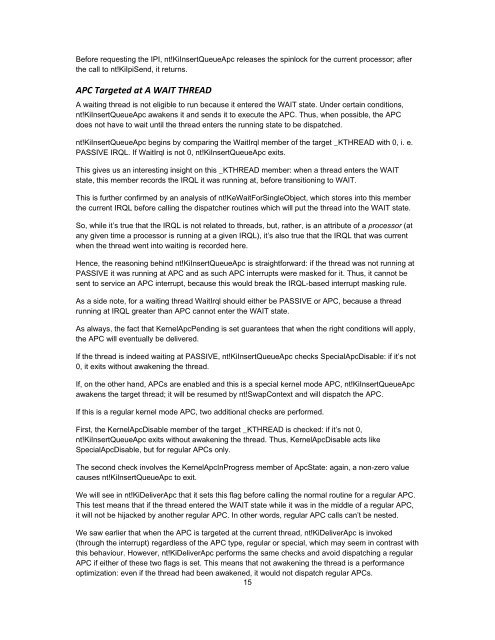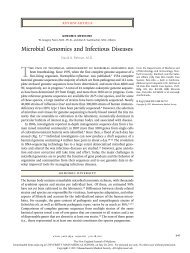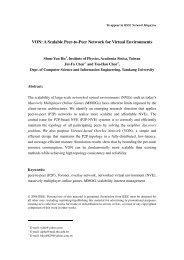366.7 KB - Evernote
366.7 KB - Evernote
366.7 KB - Evernote
You also want an ePaper? Increase the reach of your titles
YUMPU automatically turns print PDFs into web optimized ePapers that Google loves.
Before requesting the IPI, nt!KiInsertQueueApc releases the spinlock for the current processor; after<br />
the call to nt!KiIpiSend, it returns.<br />
APC Targeted at A WAIT THREAD<br />
A waiting thread is not eligible to run because it entered the WAIT state. Under certain conditions,<br />
nt!KiInsertQueueApc awakens it and sends it to execute the APC. Thus, when possible, the APC<br />
does not have to wait until the thread enters the running state to be dispatched.<br />
nt!KiInsertQueueApc begins by comparing the WaitIrql member of the target _KTHREAD with 0, i. e.<br />
PASSIVE IRQL. If WaitIrql is not 0, nt!KiInsertQueueApc exits.<br />
This gives us an interesting insight on this _KTHREAD member: when a thread enters the WAIT<br />
state, this member records the IRQL it was running at, before transitioning to WAIT.<br />
This is further confirmed by an analysis of nt!KeWaitForSingleObject, which stores into this member<br />
the current IRQL before calling the dispatcher routines which will put the thread into the WAIT state.<br />
So, while it’s true that the IRQL is not related to threads, but, rather, is an attribute of a processor (at<br />
any given time a processor is running at a given IRQL), it’s also true that the IRQL that was current<br />
when the thread went into waiting is recorded here.<br />
Hence, the reasoning behind nt!KiInsertQueueApc is straightforward: if the thread was not running at<br />
PASSIVE it was running at APC and as such APC interrupts were masked for it. Thus, it cannot be<br />
sent to service an APC interrupt, because this would break the IRQL-based interrupt masking rule.<br />
As a side note, for a waiting thread WaitIrql should either be PASSIVE or APC, because a thread<br />
running at IRQL greater than APC cannot enter the WAIT state.<br />
As always, the fact that KernelApcPending is set guarantees that when the right conditions will apply,<br />
the APC will eventually be delivered.<br />
If the thread is indeed waiting at PASSIVE, nt!KiInsertQueueApc checks SpecialApcDisable: if it’s not<br />
0, it exits without awakening the thread.<br />
If, on the other hand, APCs are enabled and this is a special kernel mode APC, nt!KiInsertQueueApc<br />
awakens the target thread; it will be resumed by nt!SwapContext and will dispatch the APC.<br />
If this is a regular kernel mode APC, two additional checks are performed.<br />
First, the KernelApcDisable member of the target _KTHREAD is checked: if it’s not 0,<br />
nt!KiInsertQueueApc exits without awakening the thread. Thus, KernelApcDisable acts like<br />
SpecialApcDisable, but for regular APCs only.<br />
The second check involves the KernelApcInProgress member of ApcState: again, a non-zero value<br />
causes nt!KiInsertQueueApc to exit.<br />
We will see in nt!KiDeliverApc that it sets this flag before calling the normal routine for a regular APC.<br />
This test means that if the thread entered the WAIT state while it was in the middle of a regular APC,<br />
it will not be hijacked by another regular APC. In other words, regular APC calls can’t be nested.<br />
We saw earlier that when the APC is targeted at the current thread, nt!KiDeliverApc is invoked<br />
(through the interrupt) regardless of the APC type, regular or special, which may seem in contrast with<br />
this behaviour. However, nt!KiDeliverApc performs the same checks and avoid dispatching a regular<br />
APC if either of these two flags is set. This means that not awakening the thread is a performance<br />
optimization: even if the thread had been awakened, it would not dispatch regular APCs.<br />
15
















